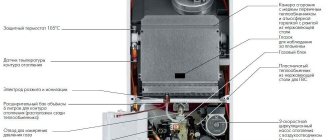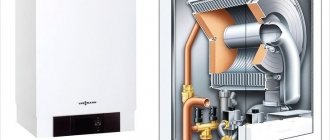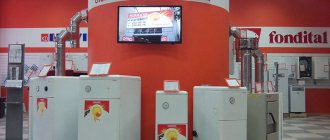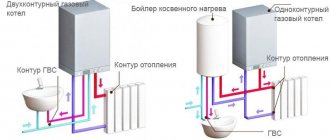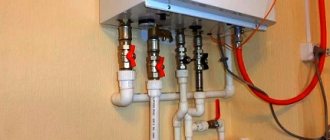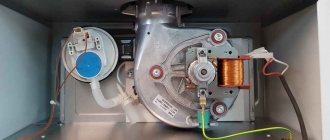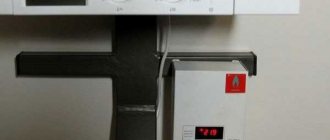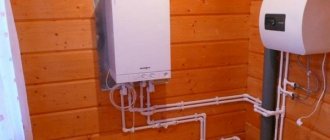If you want to purchase a gas boiler for a country house, you will have to take into account many nuances - the characteristics of the building, your own needs and the parameters of different types of boilers. The required amount of heat and hot water will determine the power of the boiler, and the installed ventilation and heating systems have their own equipment requirements.
There is a huge variety of gas boilers on the market, so you can always find the right option for each specific case. It is important to make a list of key requirements and choose accordingly. There are few external differences between gas boilers for heating, but the technical characteristics can be very diverse.
What it is?
A heating unit designed to heat the coolant and supply it to the heating circuit.
Wall-mounted models are mounted in a hinged manner on solid walls. Since the load on the supporting structures should not exceed a certain limit, wall-mounted models are not too large. Their power is limited to 40-50 kW, and the most popular are models from 15 to 16 kW, designed to heat rooms from 150 to 260 m2.
Such units have an attractive appearance, which allows them to be installed in kitchens or hallways. Installation is allowed only on sufficiently strong walls - a plasterboard partition cannot be a load-bearing surface. Separate premises are not required for them, but installing gas equipment in living rooms is prohibited by the rules. If the model is equipped with an open type burner, then installation is allowed only in rooms with a closing door (for example, in the kitchen).
Water heating
Undoubtedly, when asked what types of heating there are, it is water heating that first comes to mind. Water heating has the following advantages:
- Not very high surface temperature of various devices and pipes;
- Provides the same temperature in all rooms;
- Fuel is saved;
- Increased service life;
- Quiet operation;
- Easy to maintain and repair.
The main component of a water heating system is the boiler. Such a device is necessary to heat water. Water is the coolant in this type of heating. It circulates through closed pipes, and then the heat is transferred to various heating components, and from them the entire room is heated.
Components of water heating
The simplest option is natural circulation. This circulation is achieved due to the fact that different pressures are observed in the circuit. However, such circulation can also be of a forced nature. For such circulation, water heating options must be equipped with one or more pumps.
After the coolant passes through the entire heating circuit, it is completely cooled and returned back to the boiler. Here it heats up again and thus allows the heating devices to produce heat again.
Classification of water heating systems
Water heating type may vary according to criteria such as:
- water circulation method;
- location of distribution lines;
- structural features of risers and the diagram according to which all heating devices are connected.
In a pump heating system, heating of the coolant can also take place thanks to a hot water boiler room, or thermal water that comes from a thermal power plant. In a heating system, water can even be heated by steam.
Water heating with circulation pump
The disadvantage of direct-flow connection is the dependence of the thermal regime on the “impersonal” temperature of the coolant in the external-type supply heat water.
Where are they used?
As a rule, single-circuit boilers are used only for space heating. They are installed in a gap in the heating circuit, where they become the starting and ending point of the circulation cycle.
Single-circuit boilers are used to heat different rooms:
- private houses;
- apartments;
- dacha;
- offices;
- workshops;
- shops, etc.
Initially, these units were used for heating auxiliary premises, workshops, shops, etc. However, practice of use has shown their noticeable advantage over dual-circuit models. If an indirect heating boiler is used in conjunction with a single-circuit boiler, the supply of hot water is more stable and does not affect the quality of heating of the house; the only condition is the installation of a unit whose power is 10-15% higher than the value required for a given area.
Such a power reserve is needed to service the boiler, and the size of this reserve is determined by the volume of the heater. For a family with large needs for hot water (for example, if there are small children), choosing a single-circuit boiler paired with a storage boiler is the best option, allowing you to use hot water in unlimited quantities.
When choosing a gas boiler model, you should determine your hot water needs. If they are small, you can buy a double-circuit boiler and save on buying a boiler. However, if the needs for domestic hot water are quite large, a single-circuit model would be the best solution.
How does an open heating system work?
There is no need to install a pump to start the system. The coolants are constantly in a closed system, so there are no losses. Installation of the heating system is so simple that it does not require special skills.
Open heating system
What are the main parts of the system?
- Gas or solid fuel boiler. The consumer can choose the best option that meets the desired requirements;
- Heating radiators. You can make your choice in favor of either cast iron or steel;
- Expansion tank made of steel;
- Pipes.
How does an open heating system work?
The first step is to heat the water in the boiler. Hot water then flows under pressure into the pipes and reaches the low pressure zone. After the hot water makes a complete whirlpool and gives off heat, it returns to the starting point - the boiler. Due to the fact that water expands under the influence of high temperatures, an expansion tank is required in the system. It acts as a compensator for excess water volume. The tank is an object that is not sealed hermetically. To make it easier to start the heating system, it is necessary to install a mortise tap. With its help, air is removed from the system. The operating principle of an open heating system is divided into two stages:
- "Innings". The water is heated, flows through pipes into radiators and heats the room;
- "Treatment". The cooled water from the radiators is returned through the pipes to the boiler.
Features of the arrangement of an open heating system:
Be sure to place the expansion tank above the level of other heating system devices;
Choose water rather than antifreeze as the coolant; Since water can evaporate when heated, it is important to monitor its level in the boiler and replenish reserves in a timely manner.
Device, design features
The design of a single-circuit boiler is a flow-through heater, the main element of which is a gas burner and a heat exchanger. They are combined into one unit, which allows creating conditions for maximum fuel combustion efficiency.
There are two burner designs:
- open (or atmospheric) . It was originally used on non-volatile models, but today it is also found on modern designs. Combustion air is taken directly from the room, which simplifies the operation of the burner, but makes it dependent on drafts, pressure changes and other external conditions;
- closed (turbocharged) . A turbofan is installed to supply air. The air flow is stabilized and does not depend on external factors. The smoke is also removed using a fan, which eliminates backdraft and other undesirable effects.
Boilers with a closed burner are much more convenient and safer. But they depend on the condition of the fan and require power supply.
What is the burner design in your gas heating boiler?
OpenClosed
There are models with different heat transfer methods:
- convection _ These are boilers equipped with conventional open or closed burners;
- condensation _ These are structures in which the coolant is heated in stages. First, primary heating is carried out using thermal energy obtained by condensing water vapor from flue gases. For this purpose, the boiler is equipped with a special condensation chamber. The second stage is conventional convection heating in a heat exchanger.
Expert opinion
Torsunov Pavel Maksimovich
Convection models are much more widespread than condensation models. They are able to work in any conditions and do not require any additional devices. Condensation models appeared relatively recently. They are only able to work under certain conditions.
For example, the difference between the temperature of indoor and outdoor air should not exceed 20°, otherwise the condensation process will become impossible. For Russia, where in the cold season the temperature difference is about 25°-35° or more, the use of such structures is useless. Considering that their cost is almost twice as high as that of conventional condensing models, the lack of demand is understandable.
Types of single-circuit heating
There are several classifications of single-circuit heating systems depending on various parameters. Initially, the main types of systems should be identified:
- open;
- closed.
Since water has a fairly high coefficient of expansion when heated (0.3% due to an increase in temperature every 10 degrees), it is necessary to compensate for the increasing volume of coolant so that the pipes are not damaged and an accident is avoided. Compensation is usually carried out through an expansion tank into which a polymer membrane is inserted. This membrane is elastic and, under the influence of increasing water volume, fills the tank completely.
The use of such membrane tanks is typical for closed, fully automated systems. Boilers for such systems operate on gas, pellets, and fuel oil. They are safe because when the pressure increases, the system automatically turns off.
Previously, predominantly single-circuit open-type systems were used, which were also called natural circulation heating systems. In such devices, a pipe is installed through which excess pressure and vapor are released into the atmosphere if intensive operation of the boiler causes a significant expansion of the coolant.
Heating installations for a private cottage are also divided into systems with:
- natural circulation;
- forced circulation.
Forced circulation is carried out by including special pumps and other engineering devices for pumping water into the system. This option is considered more modern, does not require the use of pipes, fittings of a larger diameter, and therefore additional labor costs, and is more suitable for multi-storey cottages where it is necessary to supply coolant to the upper floors. The use of pumps is difficult if there are problems with a constant, powerful power supply.
Spider system
The so-called “Spider” system refers to single-circuit natural circulation installations. Today, this principle of constructing a connection between the boiler and the lines leading to the radiator is considered outdated and is used mainly in settlements remote from regional centers, where problems with energy supply may arise. In appearance, the system really resembles a spider (the boiler is installed in the attic, with lines running from it), which is why it received this name among the common people. The installation is carried out with your own hands.
Leningradka system
The most reliable systems, which is also a variant of natural circulation, include Leningradka. "Leningradka" is the optimal price-quality ratio, taking into account the ease of project implementation and efficiency. The classic “Leningradka” is a complex of series-connected radiators along the perimeter of the premises with a single pipeline; the heating source is a boiler. This option is often installed in small two-story cottages using a circulation pump.
Advantages and disadvantages
The advantages of single-circuit wall-mounted gas boilers are:
- compact size and attractive appearance;
- the absence of an additional heat exchanger simplifies the design and makes the unit more reliable;
- absence of noise during operation, allowing the boiler to be installed in kitchens or bathrooms;
- economical fuel consumption;
- stable operation, no loss of thermal energy;
- the ability to connect an external storage boiler, providing hot water in large quantities.
The disadvantages of single-circuit gas wall-mounted boilers are:
- existing restrictions in size and power make it impossible to use units in large houses or large premises;
- for a full supply of hot water, additional equipment (boiler) is required;
- most models are sensitive to water quality and stable power supply;
- Despite the limited functionality, care and maintenance of boilers is no less than when using double-circuit models.
The disadvantages of single-circuit wall-mounted models are not considered too significant, so many experts attribute them to design features.
Air heating
These types of heating of various premises are considered one of the oldest. For the first time such a system was used before our era. Today, such a heating system has become widespread - both in public buildings and industrial premises.
Air heating of a private house
Heated air is also popular for heating buildings. When recirculated, such air can be supplied to a room, where the process of mixing with indoor air occurs and, thus, the air is cooled to room temperature and heated again.
In air heating systems, the air is heated by air heaters. The primary heater for such components is hot steam or water. In order to warm the air in the room, you can use other heating devices or any heat sources.
Local air heating
When asked what kind of heating there is, local heating is often equated only to industrial premises. Local heating devices are used for rooms that are used only during certain periods, in rooms of an auxiliary nature, in rooms that communicate with external air flows.
The main devices of the local heating system are a fan and a heating device. For air heating, devices and devices such as air heating devices, heat fans or heat guns can be used. Such devices operate on the principle of air recirculation.
Heat gun
Central air heating
Central air heating is done in rooms of any type, if the building has a central ventilation system. These types of heating systems can be organized according to three different schemes: with direct-flow recirculation, with partial or complete recirculation. Full air recirculation can be used mainly during non-working hours for standby types of heating, or to heat the room before the start of the working day.
Central air heating
However, heating according to such a scheme can take place if it does not contradict any fire safety rules or basic hygiene requirements. For such a heating scheme, a supply ventilation system should be used, but the air will be taken not from the street, but from those rooms that are heated. The central air heating system uses such structural types of heating devices as: radiators, fans, filters, air ducts and other devices.
Air curtains
Cold air can come in in large quantities from the street if the entrance doors in the house are opened too often. If you do not do anything to limit the amount of cold air that enters the room, or do not heat it, then it can negatively affect the temperature regime, which should correspond to the norm. To prevent this problem, you can create an air curtain in the open doorway.
Limiting the amount of cold air entering from outside the building takes place thanks to design changes in the entrance to the room.
Electric air curtains
Compact air-thermal curtains have become increasingly popular lately. The most effective curtains are considered to be “shielding” type curtains. Such curtains create a jet air barrier that will protect the open doorway from the penetration of cold air currents. As a comparison of heating types shows, such a curtain can reduce heat loss by almost half.
Well-known companies and manufacturers
Single-circuit wall-mounted gas boilers are popular devices that are in high demand. For this reason, such designs are produced by all well-known manufacturers of heating devices.
Recognized leaders in this field of technology are German companies:
Italian companies practically do not lag behind them either in quality or in price:
Gas boilers from Czech and Slovak companies are distinguished by high quality and affordable prices:
In addition to them, Korean boilers from Navien or Kiturami, as well as Russian Lemax, Aton, Siberia, ZhMZ, are widely known. All these models are of high quality, capable of working in different conditions and performing their tasks in residential, public or industrial premises.
Comparison of popular boilers with open and closed combustion chambers
Let's look at the differences between two types of boilers from the same series using the example of popular wall-mounted double-circuit gas models with a power of 23 kW (for a heated area of up to 230 m2): Protherm Gepard 23 MTV and Protherm Gepard 23 MOV.
| Protherm Cheetah 23 MTV | Protherm Cheetah 23 MOV | |
| The combustion chamber | closed | open |
| Efficiency | 93,20% | 90,30% |
| Max. gas consumption in heating mode (G20) | 2.9 m3/hour | 2.7 m3/hour |
| Boiler weight | 34 kg | 31 kg |
| Dimensions (H x W x D) | 740x410x310 mm | 740x410x310 mm |
| Price | 61640 rubles | 58698 rubles |
Installation features
Installation of wall-mounted boilers is carried out in a certain sequence. Installation is carried out on a solid, ideally load-bearing (outer) wall. This is an important point, since models with a closed burner use a coaxial chimney (pipe-in-pipe design) that is vented outside.
As a rule, the delivery set includes a special template according to which the wall is marked. Mark the attachment points and the center of the hole for the chimney.
The hole is made with a diamond crown using special guides that feed the cutting tool onto the wall. While drilling, it is recommended to water the crown, otherwise there will be a huge amount of dust and it will become impossible to work.
After making the hole, the chimney is led into it. It is a double pipe. Air is supplied through the outer one, and smoke is exhausted through the inner one. All gaps are sealed with insulating material and the installation of the boiler itself begins.
The unit is fixed with special fasteners included in the delivery set. Connect the gas supply pipe, water make-up pipe, forward and return lines of the heating circuit. All connections must be made carefully and carefully so as not to mix up any pipelines.
The last step will be to connect the boiler to the power supply, fill it with water, supply gas and test switch it on. All detected deficiencies are immediately eliminated.
Expert opinion
Torsunov Pavel Maksimovich
Installation, configuration and first start-up must be performed by service center employees. This is a condition of the warranty agreement. If installation and connection are performed independently, the warranty agreement may be considered terminated. In addition, independent connection of gas equipment is prohibited by current rules, so it is necessary to invite specialists.
What documents will the developer need to install the boiler?
Despite its apparent simplicity, it is hardly possible to carry out installation without the involvement of specialized organizations. Moreover, before starting the installation of a floor-standing gas boiler, it is necessary to prepare a number of documents.
You will need:
- Agreement for the supply of natural gas for an individual developer.
- Technical conditions for connection.
- Equipment installation project agreed with the gas service.
After the installation company completes its work, the facility is handed over to the gas service engineer. The correct connection is checked and the equipment complies with the design and standards. Upon successful completion, the consumer receives permission to use the system.
Exploitation
All rules and requirements for the operation of a gas single-circuit boiler are described in detail in the instructions, which must be carefully studied.
Each model differs from others in certain specific features, so it is important to understand in advance all the requirements set forth by the manufacturer.
In addition, it is necessary to create conditions for trouble-free operation of the boiler. Experts recommend using a voltage stabilizer, since the electronic control unit is sensitive to the quality of the power supply. If surges occur or the voltage does not meet the specified parameters, errors may occur, and sometimes the control unit burns out.
When connecting to the power supply network, it is imperative to make a good grounding, otherwise the self-diagnosis system will begin to give incorrect information and constantly show an error.
Water quality is also an important factor. If the water in the region is too hard, softeners and special filters must be used. Scale in the heat exchanger slows down heat transfer, which means you have to increase the temperature. Excessive heating quickly damages boiler parts, and excessive gas consumption increases the payment amount.
Wall-mounted single-circuit gas boilers are convenient and popular sources of thermal energy in private houses, apartments and other premises. They are reliable, durable, and able to work in difficult conditions. At the same time, the user must ensure all the manufacturer’s requirements in order to keep the unit in order for its entire service life.
The main advantage of a single-circuit boiler is the ability to work in tandem with a storage boiler, which allows you to provide the room with hot water in sufficient quantities. Gas single-circuit wall-mounted boilers are highly rated by their owners and are in high demand.
Determining the appropriate model for an installation such as a gas boiler without electricity
The main guideline for determining the appropriate model of such an installation as an autonomous gas boiler without electricity is the correspondence of its heating power to the required area, and this characteristic must also correspond to the load on the installation. The double-circuit type of boiler, manufactured mainly by foreign companies, is often determined more serious price category. This is explained by the increased quality, design and more advanced functionality of the device compared to domestic analogues. At the same time, the manufacturer of the gas installation should be determined with special diligence; it is especially worth considering the presence of service centers of the represented company in the city or nearby, because the device requires maintenance and sometimes repair.
The most popular and high-quality manufacturers of gas autonomous boilers include the following companies: Italian manufacturers Alphatherm and Beretta - Italy, Slovenian company Attack, Czech-made Protherm and Swiss-made Electrolux.
Although models from domestic manufacturers are more attractive in terms of price, their reliability does not always correspond to the level of foreign analogues. Although they have their own special advantage - the models are produced according to all parameters corresponding to the use of boilers under local temperature conditions.
It is better to give preference to a gas boiler with heat exchangers for the manufacture of which cast iron or steel was used, and special attention should be paid to the first version of the material
. Such preferences can easily be explained by the impressive service life of the cast iron element, because a coolant of this type can last up to three decades, while a steel part will last no more than twenty years. In addition, cast iron coolant has high strength characteristics, since walls made of cast iron will be much thicker than those of steel, and practice shows that such a device will last much longer and more efficiently.
In addition, after many years of using a gas boiler, the heat exchanger tends to corrode. At the same time, cast iron is more advantageous than steel. Corrosion on this element of the device can occur as a result of a drop in temperature, which leads to the formation of condensation. Corrosion processes in such cases are provoked by released moisture.
In addition, the design of the heat exchanger provides for the presence of sections. If one of them is unsuitable, it is not advisable to change the entire heat exchanger; replacement is sufficient. At these production stages, all sorts of impurities are added to the cast iron, which significantly increase the strength characteristics of the boiler as a whole, which provides it with additional safety during transportation.

